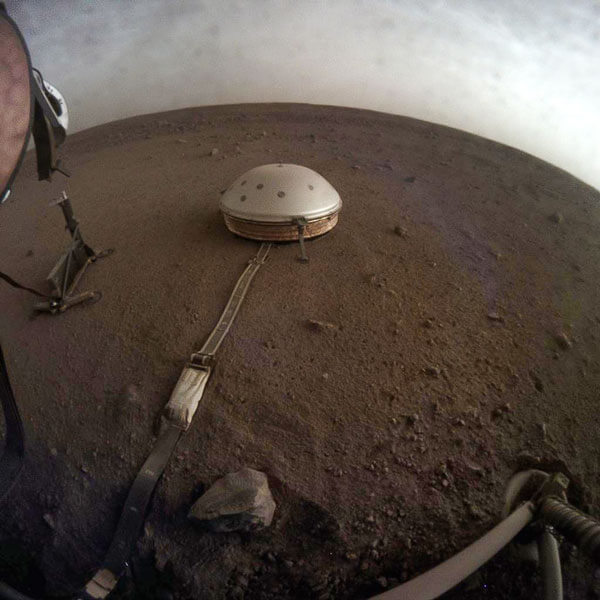- February 25, 2020
- By Kimbra Cutlip
A mission to find out what’s shaking on Mars—literally—shows that the red planet has a moderate level of seismic activity, with ground vibrations that fall short of those on Earth, but outstrip the moon’s.
An international team that includes University of Maryland geologists released preliminary results from the InSight mission, which landed a probe on Mars in November 2018. Data from the mission’s Seismic Experiment for Interior Structure (SEIS) provided the first direct seismic measurements of the Martian subsurface and upper crust—the rocky outermost layer of the planet. The results were published yesterday in a special issue of the journal Nature Geoscience.
 “This is the first mission focused on taking direct geophysical measurements of any planet besides Earth, and it’s given us our first real understanding of Mars’ interior structure and geological processes,” said Nicholas Schmerr, an assistant professor of geology at UMD and a co-author of the study. “These data are helping us understand how the planet works, its rate of seismicity, how active it is and where it’s active.”
“This is the first mission focused on taking direct geophysical measurements of any planet besides Earth, and it’s given us our first real understanding of Mars’ interior structure and geological processes,” said Nicholas Schmerr, an assistant professor of geology at UMD and a co-author of the study. “These data are helping us understand how the planet works, its rate of seismicity, how active it is and where it’s active.”
The seismic data acquired over 235 Martian days showed 174 seismic events, or marsquakes. Of those, 150 were high-frequency events that produced ground shaking similar to that recorded on the moon by the Apollo program. The quakes’ waveforms show that seismic waves bounce around as they travel through the heterogeneous and fractured Martian crust. The other 24 quakes observed by SEIS were predominantly low-frequency events. Three showed two distinct wave patterns similar to quakes on Earth caused by the movement of tectonic plates.
“These low-frequency events were really exciting, because we know how to analyze them and extract information about subsurface structure,” said Vedran Lekic, an associate professor of geology at UMD and a co-author of the study. “Based on how the different waves propagate through the crust, we can identify geologic layers within the planet and determine the distance and location to the source of the quakes.”
The researchers identified the source location and magnitude of three of the low-frequency marsquakes, and believe that 10 more are strong enough to reveal their source and magnitude once they are analyzed.
Understanding seismic processes can help answer bigger questions about the planet, Schmerr said.
“Can it support life, or did it ever?” he said. “Life exists at the edge, where the equilibrium is off. Think of areas on Earth such as the thermal vents at the deep ocean ridges where chemistry provides the energy for life rather than the sun. If it turns out there is liquid magma on Mars, and if we can pinpoint where the planet is most geologically active, it might guide future missions searching for the potential for life.”
Detecting signs of life was the primary mission of the earlier Mars probes, Viking 1 and Viking 2, in the 1970s. Each carried seismometers, but they were mounted directly on the landers and provided no useful data.
The InSight mission is dedicated specifically to geophysical exploration, so engineers worked to solve previous noise problems. A robotic arm on the lander placed the SEIS seismometer directly on the Martian ground some distance away to isolate it from the lander. The SEIS seismometer is sensitive enough to discern very faint ground vibrations, which on Mars are 500 times quieter than ground vibrations found in quietest locations on Earth.
In addition, the seismometer provided important information about Martian weather: Winds pick up from about midnight through early morning, as cooler air rolls down from highlands in the southern hemisphere onto the Elysium Planitia plains in the northern hemisphere, where the lander is located. During the day, heating from the sun causes convective winds to build, reaching their peak in late afternoon. By evening, the winds die down, and conditions around the lander become quiet. From late evening until about midnight, atmospheric conditions are so quiet, the seismometer is able to detect the rumblings from deeper inside the planet.
All of the marsquakes have been detected during these quiet periods at night, but the geologic activity likely persists throughout the day.
“What is so spectacular about this data is that it gives us this beautifully poetic picture of what a day is actually like on another planet,” Lekic said.
The InSight mission is scheduled to continue collecting data through 2020.
Topics
Research